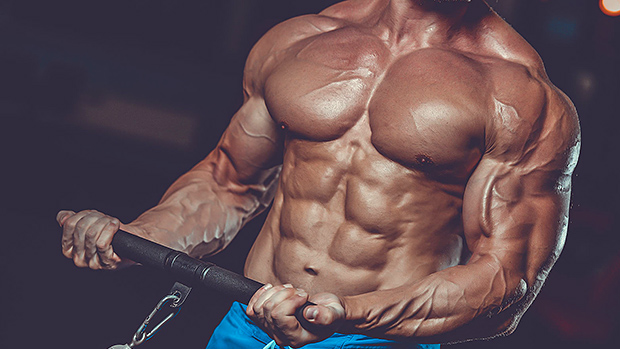Hormones are triggered in your body by practically everything you do. We will cover the most important anabolic and catabolic hormones in the body because they contribute a significant role in your muscle growth. Hormones are basically chemical messengers secreted by the endocrine system.
It is vital to understand how to influence these hormones to maximize fat loss and muscle growth. Not to mention it’s important to understand their effect on our overall health. I will keep this simple and I will not provide an endocrine lesson on these hormones because there is a lot of information. I will be giving the info you need to know only!!
Some hormones build muscle while others actually breakdown muscle. Some hormones burn fat while other hormones can actually cause you to store more of it! It’s important than we control our results as much as possible by maximizing the amount of muscle building hormones & fat loss hormones while minimizing the production of muscle breakdown hormones and fat storing hormones.
Hormone#1 Insulin
Hormone #2: Glucagon
Hormone #3: IGF-1
Hormone #4: Cortisol
Hormone#5: Testosterone
Hormone #6: Growth Hormone (GH)
Hormone#1 Insulin
This hormone is definitely a double edge sword so to speak. Insulin is released by the pancreas and can be either your best friend or worst foe. It is great when it promotes muscle building and it sucks when it promotes fat storage. The role of insulin in the body is to lower blood sugar levels when they get too high.

When you eat any sort of food it is broken down into its simplest form glucose (sugar) and released into your bloodstream. This release of sugar causes your blood sugar to rise above normal levels. Your pancreas then releases Insulin. Insulin lowers blood sugar levels by putting the glucose into muscle and liver cells.
Insulin carries amino acids into the muscles promoting protein synthesis (muscle building) and preventing protein breakdown (muscle loss). Your muscles and liver has a limited storage capacity and once they reach capacity insulin has to carry the remaining glucose somewhere else. YOU GUESSED IT YOUR FAT CELLS!! SO AS I MENTIONED EARLIER INSULIN CAN ALSO LEAD TO FAT STORAGE.
So as I mentioned earlier, insulin is a double-edged sword and you must learn to balance your insulin levels to maximize the benefits of muscle building and to minimize the affect of fat storage.
You can control insulin levels by what you eat. Different foods can cause higher insulin release than others:
- Carbs- When eaten alone carbohydrates cause the largest insulin release because they are converted directly into sugar by the body – carbs are your body’s primary energy source and they are easily converted to sugar (glucose)50g of carbs is equal to 50g of sugar entering the bloodstream. This sudden flow of sugar into the bloodstream causes a huge rise in blood sugar levels, which inevitably will cause a MASSIVE RELEASE OF INSULIN.
- Protein- When eaten alone Protein causes a smaller insulin release than carbohydrates……. only about half of dietary protein will appear in the bloodstream as sugar. The fewer carbs you eat the more likely the protein consumed is converted to glucose.
- Your liver will convert the amino acids from protein into glucose. If adequate carbs are eaten with the protein, the body will not convert the protein into glucose. Carbs are the body’s primary energy source and it would rather use those amino acids for other purposes when adequate glucose is available.
- Fats- Only a very small percentage of fat will appear in the bloodstream as glucose. Fat has almost no blood sugar increasing affect at all. When fat is digested it is primarily broken down into glycerol and free fatty acid chains (FFA). Your liver converts the glycerol into glucose.
There are really only a few hours in the day where you can eat a ton of food and create an extremely powerful anabolic environment even with the presence of high insulin levels. Remember, once your liver and muscle storage capacity is full the excess food is stored in your fat cells.
So, let me ask you this what times of the day is your muscle and liver glucose storage at their lowest levels? The answer is…….at breakfast and after your workout (cardio or weights)! These are the two main times in the day where your body will take full advantage of the anabolic effects of high insulin with a slimmest possibility of fat storage.
Hormone #2: Glucagon
Glucagon is a hormone that has a role that is parallel to insulin. Again, Insulin’s function is to lower blood sugar levels and glucagon role is to raise low blood sugar levels. Glucagon released from the pancreas comes to the save you when your blood sugar levels are low.
Like insulin, glucagon can be your best friend or your worst foe. Insulin promotes muscle building and fat storage, while glucagon promotes muscle breakdown and fat burning. If blood sugar levels are too low (if you have not eaten for more than 3-4 hours) it mobilizes stored glycogen from the liver and releases glucose for energy.
It then begins to help release stored fat into the bloodstream also to be used for energy. However, for very low blood sugar levels such as when you have not eaten for 4-5 hours (during sleep) glucagon plays a role in the breakdown of hard gained muscle for fuel. During fat loss diets, elevated glucagon levels are important because it causes the burning of stored fat for fuel.
Hormone #3: IGF-1
IGF-1 isn’t a top-secret chemical, nor is it a dangerous steroid. IGF1 is actually a natural molecular structure similar to insulin. IGF-1 is the abbreviation for Insulin-Like Growth Factor 1. IGF-1 or Insulin-like Growth Factor 1 plays a vital role in childhood growth and stimulates anabolic effects (muscle building) in adults.

There are 70 inter-connected amino acids that make up a single chain of IGF-1. IGF-1 is a hormone that is produced when the liver is stimulated by human growth hormone. When levels of HGH rise in the blood, the liver responds by producing more IGF-1. These higher “bursts” spur growth and regeneration by the body’s cells, especially in muscle cells.
Increases in IGF-1 levels have shown positive effects on increases in muscle strength, size, and efficiency. When you do not have enough IGF-1 in your body, whether caused by disease, malnutrition or a hormone imbalance, your growth can be stunted.
The primary purpose of IGF-1 is to stimulate cell growth. Every cell in the human body can be affected by IGF-1, but cells in muscle, cartilage, bone, liver, kidney, skin tissue, lungs, and nerves tend to be most positively affected.
Several scientific tests have been conducted to determine the benefits of IGF-1 and thus have prompted companies to seek approval from the Federal Drug and Administration for substances that can increase the body’s IGF-1 levels. IGF-1 can also stimulate a decrease in body fat, an increase in lean muscle mass, improved skin tone and restful sleep.
IGF-1 has also been documented to increase the rate and extent of muscle repair after injuries or strains. Not only do muscles recover more quickly, they also tend to return stronger and healthier than ever when levels of IGF-1 in the bloodstream are at their highest.
Many believe that (IGF-1) is the key factor in muscle growth. It is released from the liver during times of high insulin and high GH (growth hormone) levels. I will repeat, to stimulate the production if IGF-1, GH levels and insulin must be high simultaneously. This is the problematic part because when insulin levels are high, GH is normally kept low.
This is another reason why insulin levels must be consistently controlled. Insulin levels must be raised at specific times to promote enhanced growth and IGF-1 production. For example, to make IGF-1 work for you after a hard workout of 45 minutes your GH levels will be very high so If you then eat a high carb/high protein meal, you will cause a rise in insulin levels, which will cause the release of IGF-1.
IGF-1 is not released during times of low insulin levels. Low insulin and low IGF-1 levels are the primary reasons it is difficult to gain muscle on low-carb diets. It should be noted to that low protein intake also causes a decrease in IGF-1 levels.

Hormone #4: Cortisol
Cortisol is the most catabolic hormone in your body and is released at times of mental and physical stress. It is involved in the breakdown of muscle for energy and encourages the storage of fat. Cortisol converts amino acids to carbohydrates and prevents protein synthesis (muscle building).
In fact Cortisol may be the very reason why your muscle building efforts have failed thus far!!
FOLLOW THESE TIPS TO MINIMIZE CORTISOL LEVELS IN YOUR BODY:
- Get at least 8 hours of sleep a night. Your body needs sufficient rest or cortisol levels will elevate.
- Keep your workouts to a 45 minute max excluding warm-up time. Working out longer than this will cause Cortisol levels in the body to skyrocket!! I SUGGEST KEEPING YOUR WORKOUTS TO 30 MINUTES!!
- High set workouts with short rest periods and training too frequently will drive up cortisol levels. Training more than two days in a row, especially if you are a hard gainer, increases cortisol levels considerably. Also, it’s a good idea to take a week off from all types of training every couple of months…..long periods of training without recovery weeks can drive up levels of cortisol in the body.
- Decrease levels of personal, mental and physical stress. LEARN how to deal with daily stress. Learn how to keep your problems in perspective and FOR EVERY STRESSFUL EVENT THAT OCCURS TO YOU A PARTICULAR DAY TREAT YOURSELF TO A TIME OF RELAXATION. Stressing yourself out has shown to increase cortisol levels and inhibit muscle growth.
- Severe caloric restriction has been shown to increase cortisol levels. This is why extreme dieting and cutting phases where your calories are limited drastically for longer than 3 days results in a increase of cortisol. This is the main reason for muscle tissue loss during periods of dieting.
- A diet lacking essential micro-nutrients and macro nutrients may increase cortisol levels. Take a high quality multivitamin supplement to keep down cortisol levels.
- Cortisol levels have been shown to increase as we age. I suppose this is why a younger person can work out harder and longer in the weight room. Therefore I suggest whether you are 60 or 25 keep your workouts max 45 minutes but stay around the 30 minute mark!!
Hormone#5: Testosterone
Probably the most well known hormone its primary role is muscle growth. It also helps to burn fat and establish your sexual identity. Testosterone causes muscle growth by directly stimulating protein synthesis. Women also produce testosterone but in much smaller amounts than men do which explains why men are naturally more muscular.
Fortunately, to some extent, testosterone levels can be controlled by the our diet and exercise levels.

In order to support optimal testosterone levels your diet must be balanced and consist of plenty amounts of the B vitamins, vitamin C, zinc and manganese. When trying to gain muscle mass, a high-fat intake is necessary to stimulate maximum testosterone production. The fat provides cholesterol, which is needed for testosterone synthesis.
Heavy resistance training and short rest periods stimulate the production of higher than normal testosterone levels.
Tips to naturally increase Testosterone levels:
- The higher your stress level the lower your T.
- Intense training causes an increase in T but then it will drop. T will stay low for a day or two before rising again which is another reason for hard gainers to train every second day.
- Alcohol decreases T…… I know its sucks!!
- Diets high in protein, cholesterol, fat, and saturated fat will increase T.
- Sex, masturbation and erotic stimuli will cause an increase in T.
- Painkillers such as aspirin, marijuana, codeine will decrease T.
Hormone #6: Growth Hormone (GH)
Growth hormone promotes muscle building and fat loss. It works with testosterone to build muscle. GH helps to regenerate/strengthen our bones and connective tissue crucial to support increased muscle size and strength. GH appears to affect every organ in the body, has been shown to support protein synthesis, a positive nitrogen balance, increased amino acid uptake, lipolysis (fat breakdown), stimulate cartilage growth, and enhance immune cell function.
It is released in response to low blood sugar levels caused by dieting, exercise or sleep. Once released, it promotes growth by increasing protein synthesis, and causing the release of IGF-1. It also promotes fat burning by moving stored fat into the bloodstream to be used as energy. This is its primary function and because of this fat burning effect, GH reduces the amount of protein that is used for fuel, so high GH levels will protect against muscle breakdown and loss.

How to naturally increase GH levels
- Eat low glycemic carbohydrates to keep blood sugars low, especially before exercise and sleep.
- Go to bed on an empty stomach. Meals heavy in carbohydrates produce insulin, which can help store fat. When insulin is being released it means no GH release.
- Get a good night’s sleep on a regular basis. Large amounts of GH are released during the first 30-70 minutes of sleep and take naps when needed.
- High intensity weight training increases GH levels. While performing your sets, keep tension as high as possible on muscles without rest to optimize GH levels.
- Eat a balanced diet with frequent meals 6 times daily. This will stabilize blood sugar levels. Meals should consist of Carbs/protein/fat.
- Train using compound movements, for example, squats, dead lifts and bench-press.
- Reduce your intake of sugar. Excessive sugar intake can block activity of GH and stop the burning of fat for fuel.
